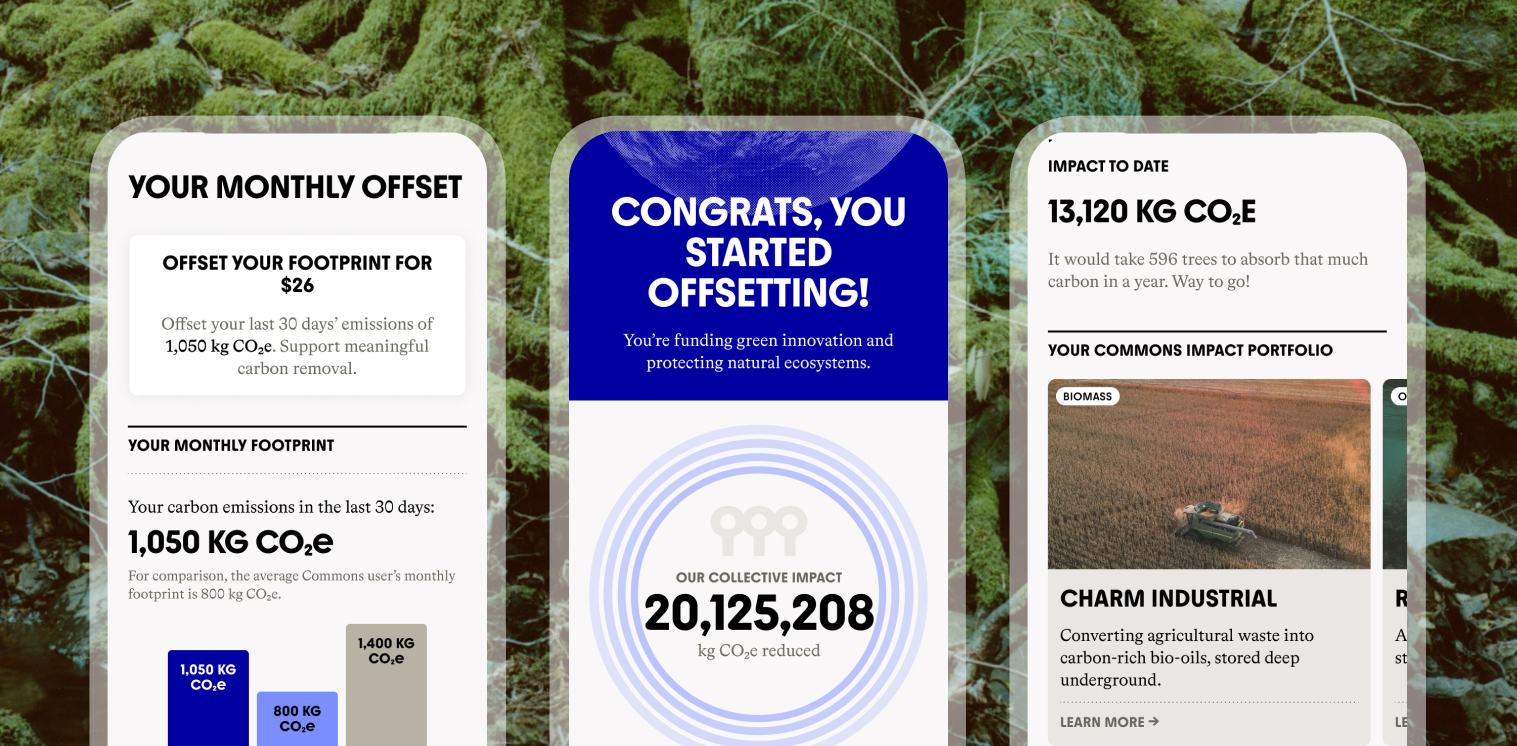Commons' Guide to Carbon Offsetting

As long as we depend on fossil fuels for energy and materials, there will be some emissions that we can’t avoid. To offset those emissions, we can support trusted climate projects that avoid new emissions and absorb existing emissions.
How carbon offsetting works
Purchasing carbon offsets is a way to compensate for your emissions by supporting projects that are drawing down emissions in one of two ways:
- They avoid emissions by replacing fossil fuel energy or protecting natural carbon sinks like forests.
- They absorb emissions by preserving or expanding natural carbon sinks, or by using technology to suck emissions out of the air.
When you offset with Commons, you support programs that have been rigorously vetted to maximize impact on global emissions and on local communities and ecosystems.
Here’s on overview of what happens when you purchase carbon offsets:
- A climate project works to draw down carbon emissions with efforts like reforestation, soil restoration, or direct air capture. A credit is created for every metric ton of emissions (equivalent to 1,000 kg CO2e) they avoid or absorb.
- These carbon credits become offsets when a person or organization purchases them to compensate for their emissions. Offsets should only be purchased once, then retired. A high-integrity climate project will not collect more offset purchases than the credits they’re creating. They also don't sell credits for emissions that would have happened with the offsets being purchased.
- After an offset if purchased, it should be retired.
Offsets in Action
Let’s say you need to fly from Phoenix to Chicago. For a standard economy class, direct flight, the emissions attributable to one passenger would be about ~440 kg CO2e.
You can lower your emissions by choosing a direct flight or a more efficient airline, but the plane will still burn fuel and create around 66 tonnes of greenhouse gas emissions in the atmosphere. To make up for those emissions, you could give enough funds to an offset organization for them to reduce or remove 440kg of CO2e from the air.

Carbon Offsetting with Commons
Globally, we need to reduce our total emissions by 45% by 2030 to prevent irreparable climate disaster.1 Offsets are not a substitute for reducing our emissions through lifestyle and systems changes, but they can help us reach our goals. Think of it like a tub full of water with the faucet running. When we reduce the amount of CO2e we're emitting, we reduce the amount of water coming out of the tap, which is critical to prevent overflow. Funding offsets is like using buckets to take water directly from the tub. Both efforts are critical.
Even in climate scientists’ most aggressive scenarios for a low-carbon future, we still need to remove emissions from the atmosphere. We can reach climate neutrality when we’re absorbing existing emissions from the atmosphere and oceans at the same rate as we’re releasing new ones. Unfortunately, offset projects are underfunded by trillions of dollars worldwide.2
With the Commons Climate Neutral subscription, you can automatically offset your emissions each month by supporting high-integrity climate projects that are avoiding or absorbing emissions. Your monthly offset amount varies each month, based solely on the number of metric tons of CO2e you emitted. When you emit more, you buy more offsets. When you emit less, you buy less offsets. You can set a monthly maximum that’s comfortable for you, so you never go over your budget.

Going climate neutral is our way to pay the Earth what we owe by taking the carbon we create out of the atmosphere.
Go Climate Neutral with Commons→
How Commons Selects Carbon Offset Projects
The market for carbon offset credits lacks regulation and standardization. Offset projects can be poorly measured, tracked, and verified, drastically overestimating their impact. When offsets are abused as a license to pollute, people in vulnerable communities are most at risk.
That’s why Commons uses critical criteria to select offset projects for our portfolio.
Our experts evaluate and monitor the best, evidence-backed offset projects on the market so you don’t have to. We regularly conduct meticulous research, consult third-party evaluations, and engage with experts to pick effective projects that support positive outcomes for people and the planet we call home. If a project fails to meet our ongoing evaluation standards, it is removed from our portfolio.
Our evaluation criteria are broken into measures of carbon integrity and measures of transformative potential.
Carbon Integrity Criteria
We screen carbon offset and removal providers to ensure the integrity of the carbon credits from their projects. Projects must actually avoid or absorb the carbon they claim to. These are our criteria for high-integrity carbon offsets:
- Verifiability: The carbon reduction or removal must be measured or rigorously evaluated by a trustworthy, independent third party.
- Enforceability: The offset vendor must provide evidence that the carbon credits issued from a project are sold once, then retired. Credits must be backed by a contract that defines exclusive ownership.
- Additionality: A project must demonstrate strong evidence that it is not taking credit for carbon reduction or removal that would have happened already, without the project.
- Permanence: To stabilize atmospheric concentrations of greenhouse gases, long-term carbon removal and storage is critical. Commons is curating a selection of projects that balance short-term and long-term carbon storage.
- Transparency: We seek to work with partners that demonstrate operational transparency and provide specific, clear, well-documented evidence of carbon reduction and removal.
Transformative Potential Criteria
Addressing the climate crisis will require fundamentally transforming our markets and society. We prioritize projects that improve the state of carbon markets and contribute creating a world for all life to thrive. These are our transformative potential criteria:
- Efficiency: Commons takes every opportunity to support efficient carbon markets by avoiding middle men. We strive to get a higher percent of overall cost directly to the project owners.
- Scalability: Commons favors scalable projects that can meaningfully contribute to reaching global drawdown by 2050. Drawdown occurs when levels of greenhouse gases in the atmosphere stop climbing and start to steadily decline.
- Catalytic potential: Commons prioritizes projects that advance innovation, demonstrate replicability, and inspire similar future projects.
- Ecosystem benefits: We support projects that create benefits to natural ecosystems beyond carbon reduction, including conservation, biodiversity, and climate adaptation benefits.
- Community benefits: The climate crisis presents enormous equity and justice challenges. We prioritize projects that will benefit the poorest and most vulnerable populations that are affected most by changing climates.
The Commons Offset Portfolio
Supporting carbon offsets can be a powerful way to invest in innovative climate solutions and protect natural ecosystems, but they aren’t a silver bullet. Each project has a unique set of risks.
With the Commons Offset Portfolio, we do the work to maximize your impact. Just as you wouldn’t put all your money into one stock, we don’t put all your dollars into a single offset project.
Our team of experts rigorously evaluated 24 offset projects to curate the Commons Offset Portfolio — a diverse mix of six partners that meet our criteria. Our offset vetting includes deep dives into analyses by third-party certifications and shared research with other rigorous, third-party buyers. We score each partner across a range of carbon integrity and transformative potential criteria. Read the full evaluations at our open-source database →

The resulting Commons Offset Portfolio includes a balanced mix of short and long-term offsetting partners:

Learn more about the Commons Offset Portfolio →
Sources
Join the community



















